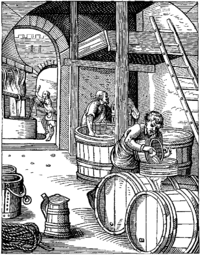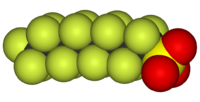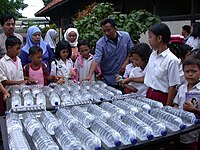
Identification of endocrine active disinfection by-products (DBPs) that bind to the androgen receptor.
Sign Up to like & getrecommendations! Published in 2017 at "Chemosphere"
DOI: 10.1016/j.chemosphere.2017.08.105
Abstract: The formation of disinfection by-products (DBPs) in drinking water occurs when chemical disinfectants such as chlorine and chloramine react with natural organic matter and anthropogenic pollutants. Some DBPs have been linked to bladder cancer and… read more here.
Keywords: dbps; disinfection products; androgen receptor; products dbps ... See more keywords

Adsorption of soluble microbial products by sediments.
Sign Up to like & getrecommendations! Published in 2019 at "Ecotoxicology and environmental safety"
DOI: 10.1016/j.ecoenv.2018.11.005
Abstract: As major precursors of disinfection by-products (DBPs), soluble microbial products (SMPs) generated by sewage discharge can adversely affect drinking water quality. It is essential to understand the adsorption behaviours of SMPs onto sediments and the… read more here.
Keywords: adsorption; dbps; drinking water; microbial products ... See more keywords

The occurrence, characteristics, transformation and control of aromatic disinfection by-products: A review.
Sign Up to like & getrecommendations! Published in 2020 at "Water research"
DOI: 10.1016/j.watres.2020.116076
Abstract: With the development of analytical technology, more emerging disinfection by-products (DBPs) have been identified and detected. Among them, aromatic DBPs, especially heterocyclic DBPs, possess relatively high toxicity compared with regulated DBPs, which has been proved… read more here.
Keywords: control aromatic; dbps; toxicity; disinfection products ... See more keywords

Removal of trihalomethanes and haloacetamides from drinking water during tea brewing: Removal mechanism and kinetic analysis.
Sign Up to like & getrecommendations! Published in 2020 at "Water research"
DOI: 10.1016/j.watres.2020.116148
Abstract: Disinfection by-products (DBPs) are associated with various adverse health effects. Diversiform advanced treatment processes have been applied for the control of DBPs, but DBPs can still be frequently detected in tap water. Tea-leaves can be… read more here.
Keywords: tea brewing; water; removal; dbps ... See more keywords

Iodide sources in the aquatic environment and its fate during oxidative water treatment - A critical review.
Sign Up to like & getrecommendations! Published in 2022 at "Water research"
DOI: 10.1016/j.watres.2022.118417
Abstract: Iodine is a naturally-occurring halogen in natural waters generally present in concentrations between 0.5 and 100 µg L-1. During oxidative drinking water treatment, iodine-containing disinfection by-products (I-DBPs) can be formed. The formation of I-DBPs was mostly… read more here.
Keywords: critical review; iodide; water; water treatment ... See more keywords

A New Group of Heterocyclic Nitrogenous Disinfection Byproducts (DBPs) in Drinking Water: Role of Extraction pH in Unknown DBP Exploration.
Sign Up to like & getrecommendations! Published in 2021 at "Environmental science & technology"
DOI: 10.1021/acs.est.1c00078
Abstract: pH adjustment prior to extraction is an important step in water sample pretreatment processes for exploration of new/unknown disinfection byproducts (DBPs) in drinking water. To achieve a better extraction efficiency, the pH of a water… read more here.
Keywords: extraction; disinfection byproducts; water; dbps ... See more keywords

Halocyclopentadienes: An Emerging Class of Toxic DBPs in Chlor(am)inated Drinking Water.
Sign Up to like & getrecommendations! Published in 2022 at "Environmental science & technology"
DOI: 10.1021/acs.est.2c02490
Abstract: Although >700 disinfection by-products (DBPs) have been identified to date, most DBPs in drinking water are still unknown. Identifying unknown DBPs is an important step for improving drinking water quality because known DBPs do not… read more here.
Keywords: toxic; drinking water; emerging class; dbps ... See more keywords

Photoconversion of Chlorinated Saline Wastewater DBPs in Receiving Seawater is Overall a Detoxification Process.
Sign Up to like & getrecommendations! Published in 2017 at "Environmental science & technology"
DOI: 10.1021/acs.est.6b04232
Abstract: Chlorine disinfection of wastewater effluents rich in bromide and iodide ions results in the formation of relatively toxic bromo- and iodo-disinfection byproducts (DBPs), especially highly toxic bromophenolic and iodophenolic DBPs, which could harm the marine… read more here.
Keywords: saline wastewater; chlorinated saline; dbps; wastewater ... See more keywords

Nonhalogenated Aromatic DBPs in Drinking Water Chlorination: A Gap Between NOM and Halogenated Aromatic DBPs.
Sign Up to like & getrecommendations! Published in 2020 at "Environmental science & technology"
DOI: 10.1021/acs.est.9b06403
Abstract: Halogenated disinfection byproducts (DBPs) are generated via reactions with natural organic matter (NOM) in chlorine disinfection of drinking water. How large NOM molecules are converted to halogenated aliphatic DBPs during chlorination remains a fascinating yet… read more here.
Keywords: halogenated aromatic; chlorination; nom halogenated; dbps ... See more keywords

Invited Perspective: Existing Rules for Disinfection By-Products Are Good, but They Are Not Enough
Sign Up to like & getrecommendations! Published in 2022 at "Environmental Health Perspectives"
DOI: 10.1289/ehp11187
Abstract: More than 250 million U.S. residents, and millions more throughout the world, drink water treated by chemical disinfectants. Although it is important to kill harmful pathogens in water, chemical disinfection results in the formation of… read more here.
Keywords: drinking water; disinfection; water; dbps ... See more keywords

Evaluation of DBPs formation from SMPs exposed to chlorine, chloramine and ozone.
Sign Up to like & getrecommendations! Published in 2017 at "Journal of water and health"
DOI: 10.2166/wh.2016.136
Abstract: Soluble microbial products (SMPs) are an important group of components in wastewater effluents. In this study, the formation of disinfection by-products (DBPs), including trihalomethanes (THMs), haloacetic acids (HAAs), chlorinated solvents (CSs), haloketones (HKs), haloacetonitriles (HANs)… read more here.
Keywords: dbps; chlorination chloramination; formation dbps; formation ... See more keywords